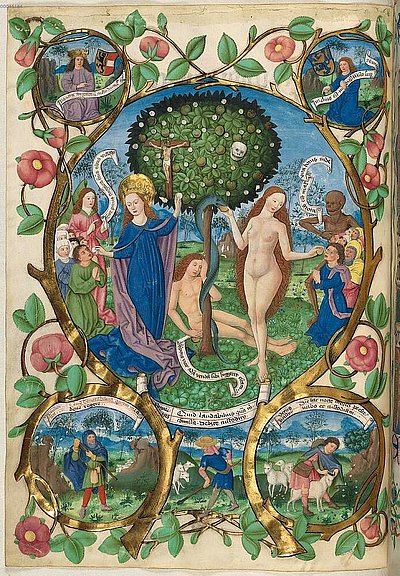
A hundred years after the blessed Mother’s Assumption into Heaven, it must have felt as if one could almost still touch her, hear her voice, feel her. It would be analogous to hearing about one’s great-grandparents from the previous century of whom some stories and belongings still survive – except that Christ and the Virgin Mary, of course, remain present in a different way.
But the reflections of the Apostolic Fathers in the 2nd century were more than a simple act of remembering, they represented a deeper understanding. After the tremendously powerful evangelization of the apostles in the onrush of the Holy Spirit, came a time of more systematic theological and philosophical reflection upon Christ and His mother. The Gospels had been written, as well as the letters and the Book of Revelation, though the canon (i.e. establishing what would go into the New Testament) still needed to be determined. Now one needed to investigate in a more articulate form what all this meant. The apostolic tradition gave the key to this, as it does today, and from these reflections would arise the tools to pronounce dogmas in the face of confusion, misunderstanding and heresy.
St Justin Martyr, St. Irenaeus (a disciple of St.Polycarp who himself had been a disciple of St. John the Evangelist) and Tertullian spoke about Mary as the second Eve without further elaboration as if it were a familiar idea. If St. Justin (ca. 100- ca. 165) had not written about this about twenty years before Irenaeus, one might have thought this insight had come to Irenaeus from St. John via Polycarp. For who better than the contemplative St. John, who took the blessed Mother into his home after Christ’s death and who is known for his deep insights, could understand her role in salvation history?
In any case, in an age where the heresy of Marcionism was denying the pertinence of the Old Testament for Christianity, Mary as the new Eve manifests the continuity between the Old and the New Testament, as Irenaeus showed. Because she had agreed to become the mother of Christ, he even called Mary “the cause of salvation” and her “womb as regenerat[ing] men unto God” thereby perhaps pre-empting, as some argue, Mary co-redemptrix and co-mediatrix (Adversus Haereses 3, 22, 4 & 4, 33, 11).
While Eve had brought about an unparalleled cataclysmic disaster upon humanity, next to which Greek tragedies resemble lighthearted comedies, Mary as the new Eve helped save the human race through her Son. Hence St. Irenaeus writes: “As Eve was seduced by the word of an angel and so fled from God after disobeying his word, Mary in her turn was given the good news by the word of an angel, and bore God in obedience to his word. As Eve was seduced into disobedience to God, so Mary was persuaded into obedience to God; thus the Virgin Mary became the advocate of the virgin Eve.” (Ad. Hr. V, 19 &1).
Eve’s lack of faith in God, i.e. trusting the serpent’s lies about God being a liar and tyrant, is replaced by Mary’s act of faith, allowing God do with her what He wants. The humility of Mary who wants to be a simple handmaiden counters the pride of Eve who had wished to become like a god. The difference is striking; the one undoes through faith what the other had done wrong through unbelief. Hence Irenaeus writes again pertinently that “thus also it was that the knot of Eve’s disobedience was loosed by the obedience of Mary.”
Tertullian (ca. 155-240) would write later along the same lines that “as Eve had believed the serpent, so Mary believed the angel. The delinquency which the one occasioned by believing, the other by believing effected.” (The Flesh of Christ 17)
Justin’s, Irenaeus’ and Tertullian’s reflections constitute the beginning of Mariology which would flower ever more over the centuries, leading to the proclamation of four different dogmas on Mary. During the Second Vatican Council, Mary would receive the title of “Mother of the Church” and Lumen gentium would again refer to her role as the new Eve: “By her belief and obedience, not knowing man but overshadowed by the Holy Spirit, as the new Eve she brought forth on earth the very Son of the Father, showing an undefiled faith, not in the word of the ancient serpent, but in that of God’s messenger” (63).
Marie Meaney
Marie Meaney